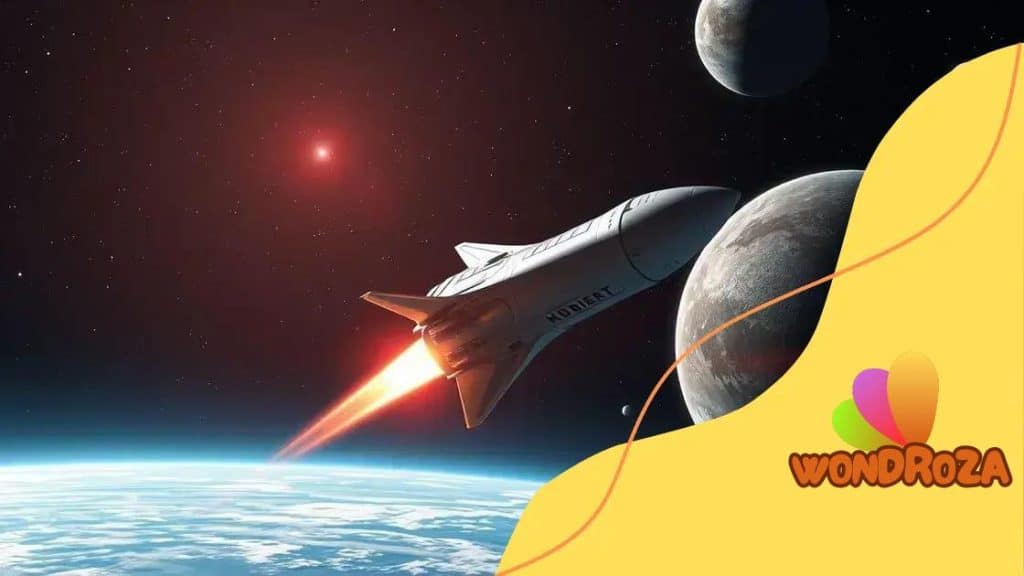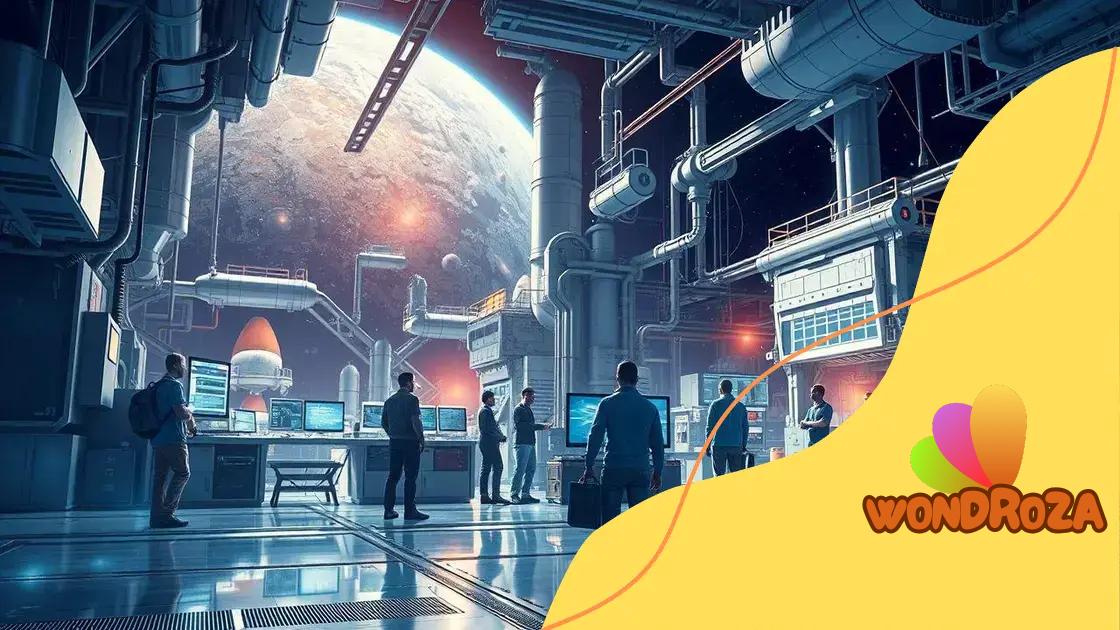Space exploration advancements and their economic implications

Space exploration advancements and their economic implications drive innovation, create jobs, and enhance global communication while opening new markets such as space tourism and resource mining.
Space exploration advancements and their economic implications are reshaping our understanding of innovation. Have you ever thought about how new technologies from space missions might influence everyday life here on Earth? Let’s dive into this fascinating connection.
The history of space exploration
The history of space exploration is a captivating journey that began decades ago. It showcases how humans have constantly sought to understand the universe. From early rocket experiments to sophisticated spacecraft, each step reflects our curiosity and ingenuity.
The Early Days
In the mid-20th century, the space race between the United States and the Soviet Union marked a crucial turning point. Innovations like the V-2 rocket laid the groundwork for future advancements. In 1957, the Soviet Union launched Sputnik, the first artificial satellite, capturing global attention.
A New Era of Exploration
The 1960s witnessed monumental milestones, including the Apollo missions. Apollo 11 in 1969 became famous when it landed astronauts on the Moon. This achievement opened the doors to new possibilities in space research and technology.
- The first human in space was Yuri Gagarin in 1961.
- NASA’s Voyager missions provided crucial data about our solar system.
- Space shuttle flights began in 1981, allowing for reusable spacecraft.
Advancements in technology have since transformed how we explore space. Telescopes and probes have expanded our knowledge about distant planets and galaxies. Today, international cooperation leads the way in missions to Mars and beyond.
Private companies are joining governments in this exploration. They are developing new technologies that push boundaries and spark interest in the cosmos. As we look forward, the history of space exploration serves as a rich foundation for future discoveries.
Key technologies driving advancements
Key technologies driving advancements in space exploration have played a vital role in pushing the boundaries of human knowledge. Innovations in robotics, materials science, and propulsion systems have made it possible to explore farther than ever before.
Robotics and Automation
Robotic technology is crucial for missions beyond Earth. Rovers, like NASA’s Perseverance, allow scientists to collect data from the surface of Mars. These machines can gather samples and conduct experiments in areas too dangerous for humans.
- Robots enhance our capabilities in extreme environments.
- They can operate autonomously or be controlled remotely.
- Advanced sensors help them analyze their surroundings.
Furthermore, automation in spacecraft design increases efficiency and safety, making space missions more feasible. Enhanced software controls various systems, enabling real-time decision-making during missions.
Materials Science Innovations
The development of new materials has revolutionized spacecraft construction. Lightweight composites and heat-resistant alloys improve the durability and performance of spacecraft. These materials allow for building more robust structures capable of enduring harsh conditions.
Additionally, advancements in thermal protection systems are essential. They safeguard spacecraft during the intense heat of re-entry into Earth’s atmosphere, ensuring the safety of astronauts and equipment.
Each of these technological strides contributes significantly to the quest for discovering more about our universe. They not only make space travel safer but also expand the options for exploration.
As we look ahead, innovations like ion propulsion and reusable rockets promise to change how we travel in space. These breakthroughs reflect our continued commitment to exploring the final frontier and understanding the cosmos.
How space exploration boosts the economy

How space exploration boosts the economy is a crucial topic that highlights the benefits of investing in space technologies. The advancements made in space have a ripple effect on many sectors, leading to increased job creation and technological innovation.
Job Creation in Various Sectors
Space missions require a diverse range of skills and expertise. From engineers to scientists, many professionals contribute to the success of these projects. This creates numerous job opportunities, not just in aerospace but also in related industries.
- Support for high-tech jobs in engineering.
- Growth in STEM education initiatives.
- Development of spin-off companies and technologies.
As governments and private companies invest more in space exploration, the demand for skilled workers grows, further enhancing job prospects across multiple fields.
Technological Innovations
The technologies developed for space travel often lead to advancements that benefit everyday life. For instance, satellite technology plays a vital role in communication, weather forecasting, and navigation systems. These advancements improve the quality of life on Earth and stimulate economic growth.
Additionally, many innovations derived from space programs, such as advancements in materials science and robotics, find applications in various industries. This cross-pollination of ideas fosters an environment conducive to innovation.
International Collaboration and Trade
Space exploration encourages international partnerships that boost trade relations. Countries working together on missions can share resources, knowledge, and expertise. These collaborations can lead to shared economic benefits and stronger diplomatic ties.
Investments in space projects can also attract private sector interest, leading to increased funding and further exploration. Overall, the economic implications of space exploration are vast, proving that the quest for knowledge can also pave the way for prosperity on Earth.
Challenges faced in space innovation
Challenges faced in space innovation are numerous and complex. As we strive to explore further into the cosmos, various obstacles hinder progress and increase mission costs. These challenges can impact the pace at which we advance our understanding of space.
High Costs of Space Missions
The financial burden of launching and maintaining space missions is substantial. Developing new technologies and spacecraft requires significant investment from both public and private sectors. Funding is often limited, leading to tough decisions about which projects to prioritize.
- Each launch can cost millions, making efficient planning critical.
- Budget constraints can delay important research and missions.
- Finding long-term funding solutions remains a challenge.
While innovations can lead to cost reductions over time, the initial investment can be a major hurdle for many organizations.
Technological Limitations
Despite advancements, we still face technological challenges. Current propulsion systems may not be adequate for long-duration missions to distant planets. There’s a need for new propulsion technologies that can reduce travel time and increase mission feasibility.
Additionally, developing life-support systems for missions to Mars or beyond poses significant issues. These systems must be reliable and provide for astronauts’ needs over long periods in isolated environments.
Regulatory and Safety Concerns
Regulations can also slow down innovation. Space is a highly regulated environment, with numerous safety and environmental standards. Compliance with these regulations can create additional delays in project development and implementation.
Furthermore, safety is a paramount concern. The potential for catastrophic failure looms over every mission. Space agencies prioritize the safety of astronauts and the integrity of each mission, ensuring that all technologies and systems are thoroughly tested before deployment.
Confronting these challenges requires collaboration among governments, private companies, and international organizations. By sharing knowledge and resources, we can overcome obstacles and continue pushing the boundaries of space exploration.
Future trends in space-related commerce
Future trends in space-related commerce promise exciting developments that could reshape industries on Earth and beyond. As technology advances and costs decrease, more opportunities will arise for businesses to engage in space exploration and utilization.
Emergence of Space Tourism
One of the most talked-about trends is the rise of space tourism. Companies like SpaceX and Blue Origin are paving the way for tourists to experience space travel. Expect to see packages for suborbital flights becoming available to the public, allowing civilians to see Earth from above.
- Space tourism could generate significant revenue for the industry.
- It will inspire a new generation interested in aerospace careers.
- Short-term flights may lead to longer stays in space hotels in the future.
This sector has the potential to open up a new market that thrives on unique experiences and innovation.
Satellite Internet and Communication
Another key trend is the expansion of satellite internet services. Companies are launching constellations of satellites to provide global internet coverage. This venture not only addresses the digital divide but also creates significant business opportunities in telecommunications.
Reliable internet access can greatly enhance education and business operations in remote areas. As more satellites are deployed, the demand for communication technologies will also rise, pushing innovation in satellite design and operation.
Space Mining and Resource Utilization
Resource extraction from asteroids and other celestial bodies is gaining attention. Several companies are exploring the feasibility of mining minerals in space. This could provide new resources that are rare or depleted on Earth, such as precious metals.
Additionally, utilizing materials in space could reduce the need to transport resources from Earth, thus lowering costs and environmental impact.
As these trends develop, collaboration between government agencies and private companies will likely increase. The growth of space-related commerce is set to create jobs, spur innovation, and enhance our capabilities in exploring the final frontier.
In conclusion, the future of space exploration is bright and full of opportunities. As we drive forward with technological advancements, the economic implications of space activities will expand significantly. From the exciting prospects of space tourism to the vital role of satellite communications, each of these developments highlights the importance of space exploration for society. By overcoming challenges, fostering innovation, and encouraging collaboration among governments and industries, we can unlock the potential of this vast frontier. The journey into space not only enriches our knowledge but also opens new pathways for growth and prosperity on Earth.
FAQ – Frequently Asked Questions About Space Exploration and Economic Implications
How does space tourism contribute to the economy?
Space tourism generates revenue and creates jobs in the aerospace industry, offering unique experiences to civilians.
What role do satellites play in global communication?
Satellites provide essential internet connectivity, enhancing communication and access to information worldwide.
Why is space mining considered important?
Space mining offers potential access to rare resources, reducing dependence on Earth’s limited materials.
How can international collaboration impact space exploration?
Collaborative efforts enable countries to share knowledge and resources, accelerating technological advancements and mission success.





